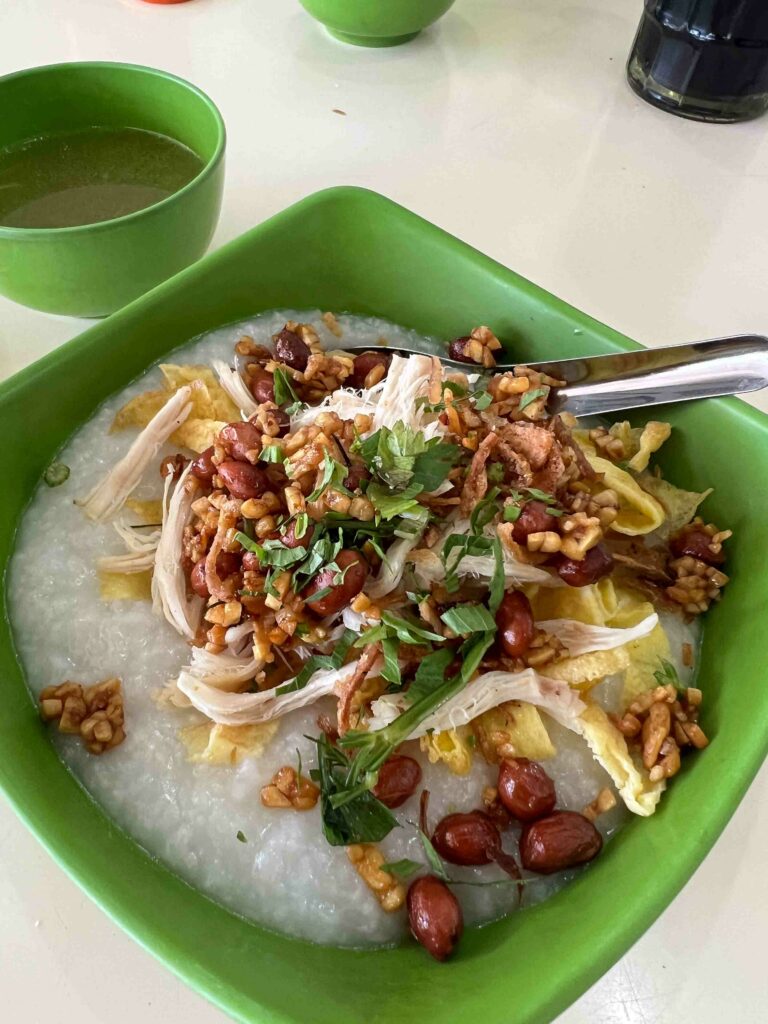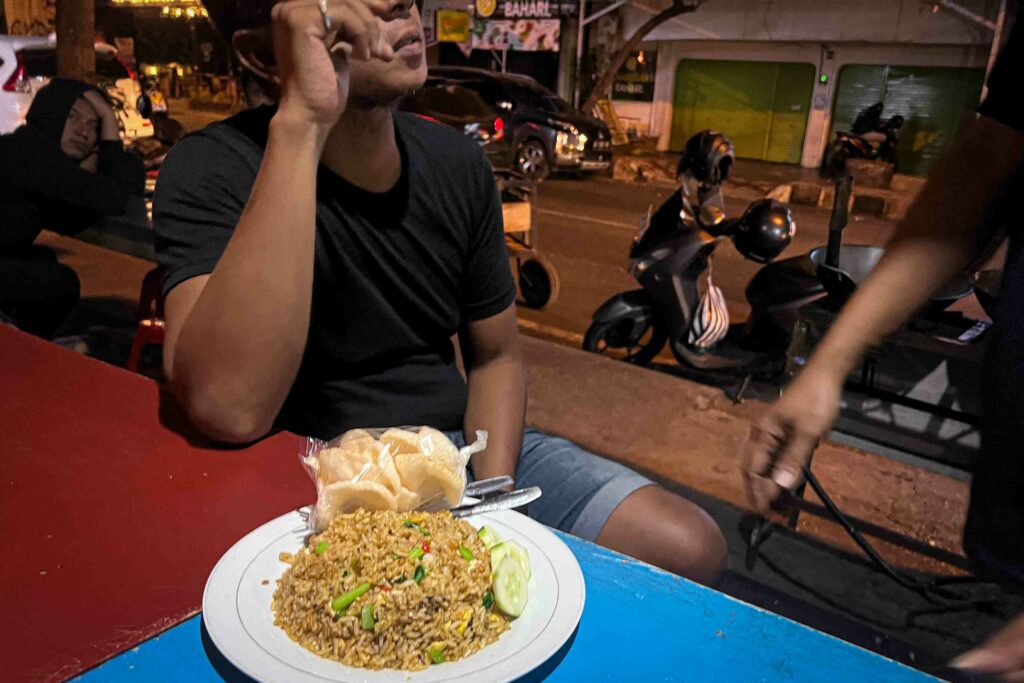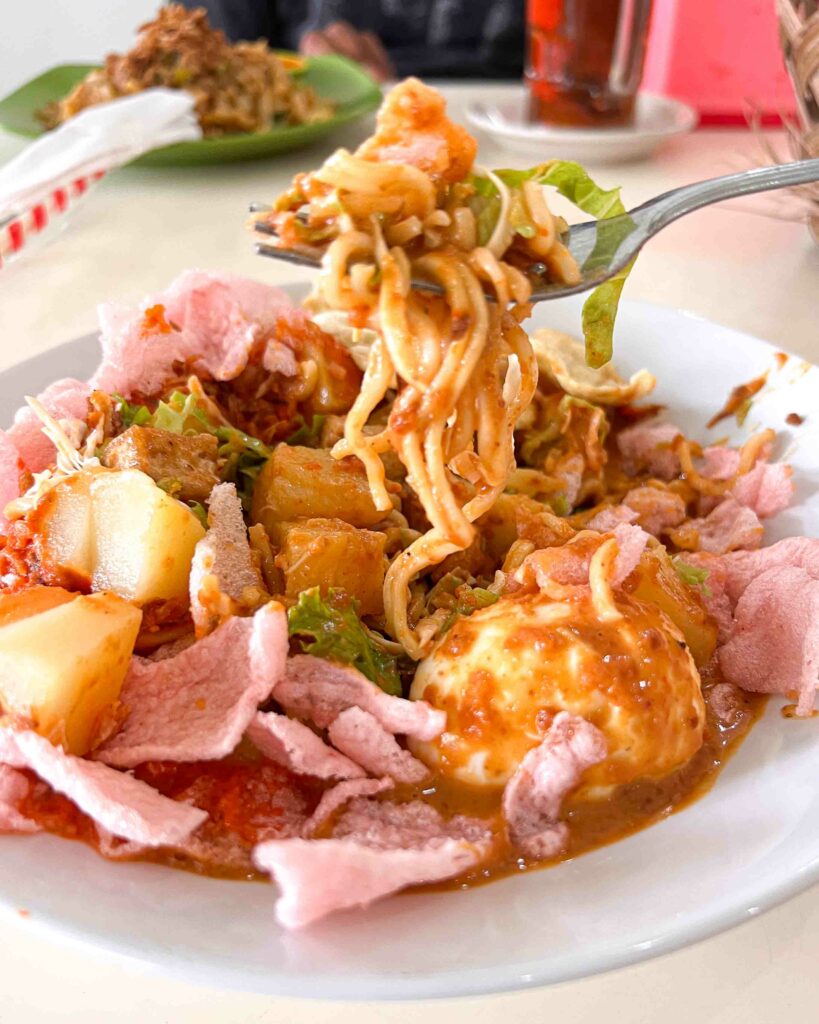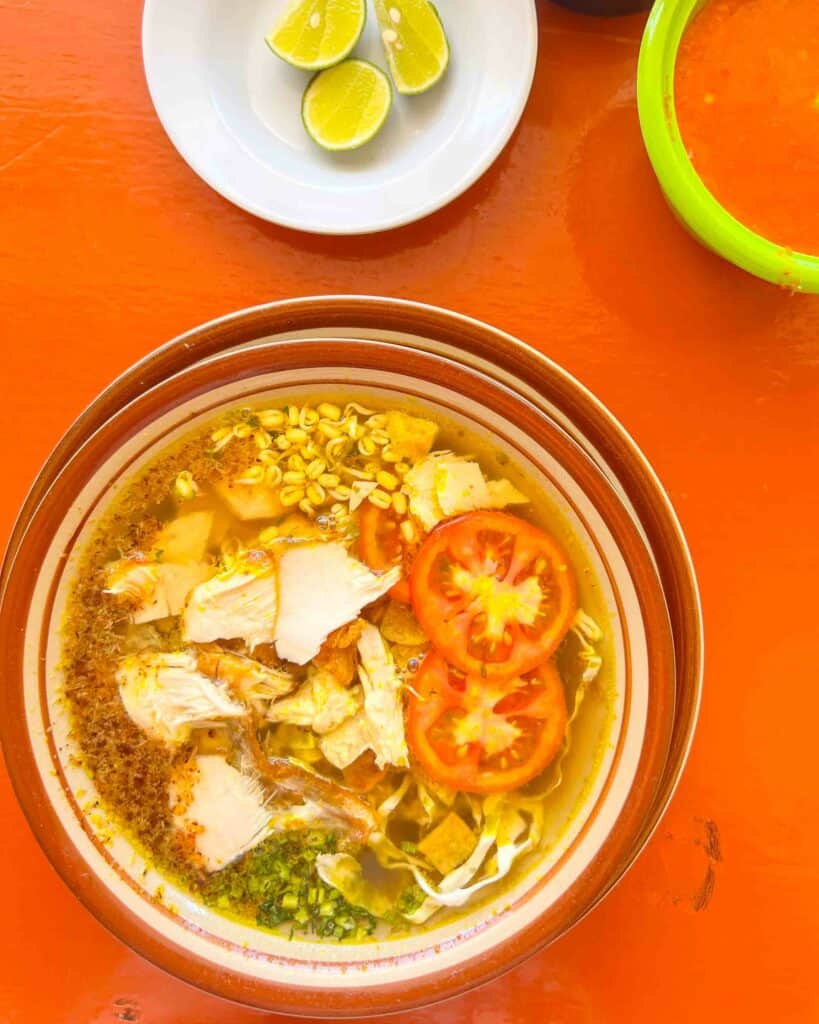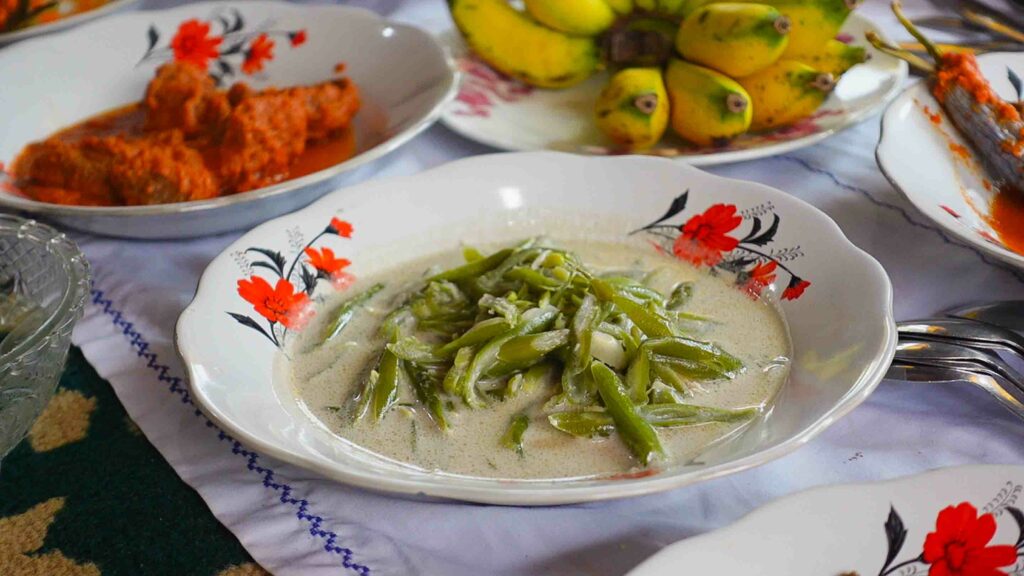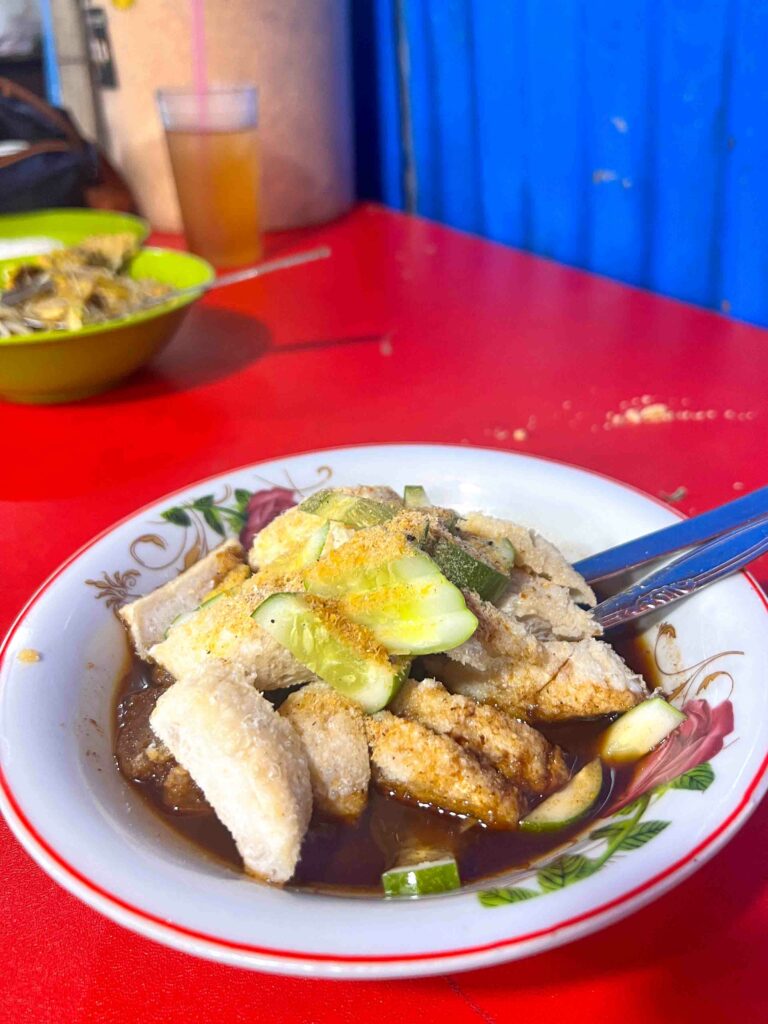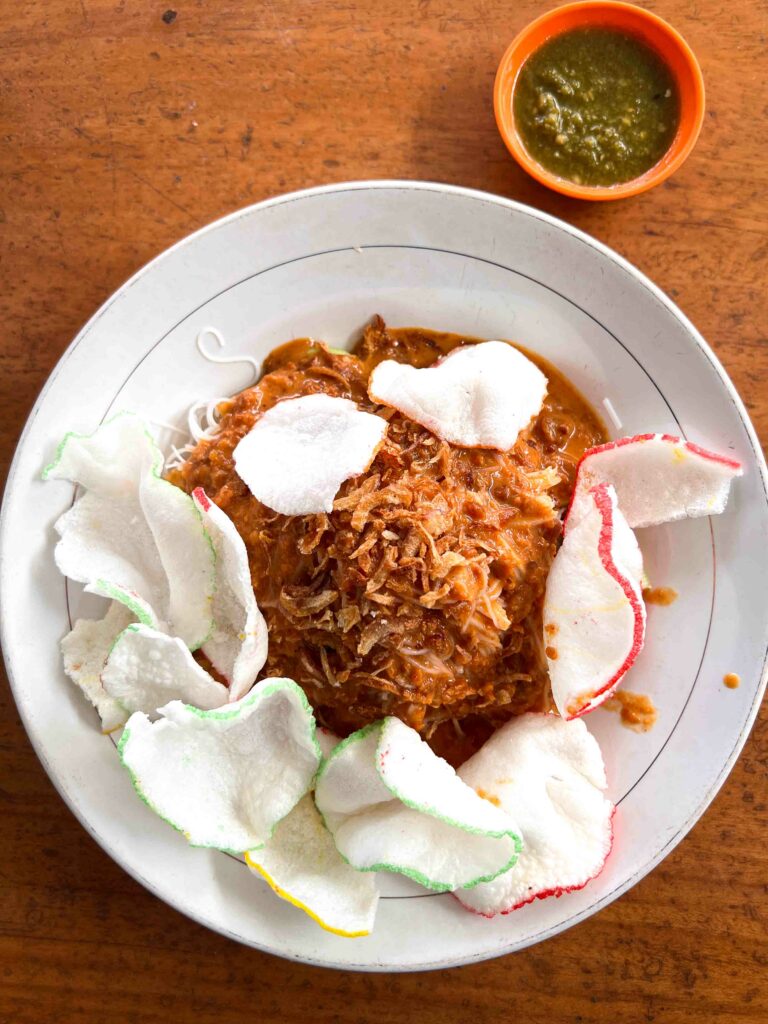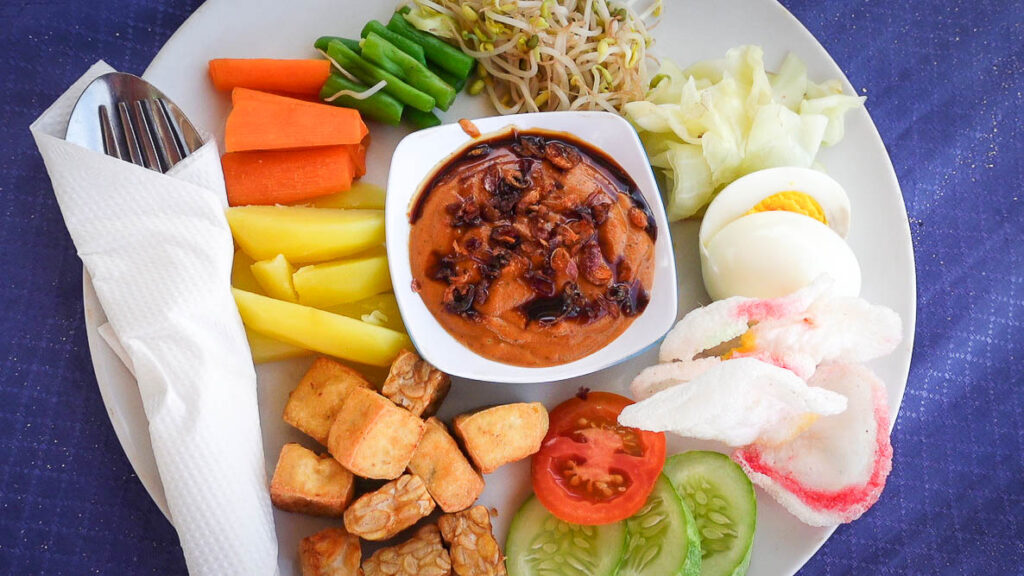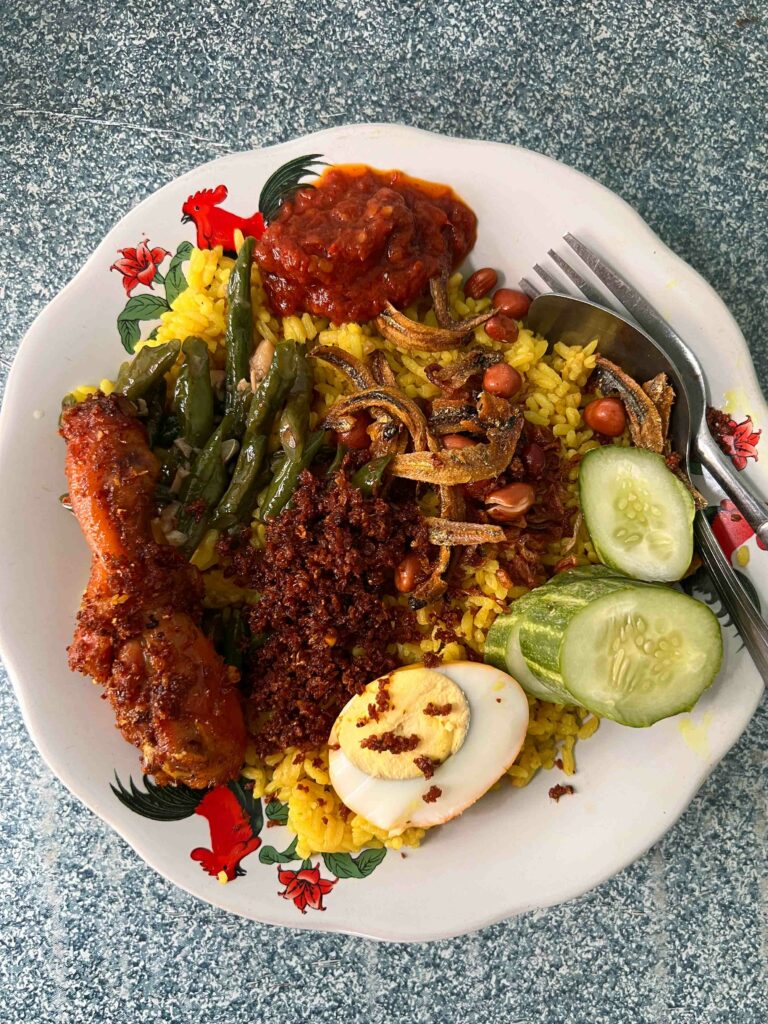Sweet or savory Indonesian breakfast is a great way to start the day. Here are 25 delicious morning foods in Indonesia that I guarantee you’ll love too,
Indonesian food is known as some of the best in the world. With over 275 million people spread across 17,000 islands there are so many possibilities or sweet, spicy and savory.
For locals, breakfast is an essential start to the day and it starts very early in the morning on the streets.
Indonesians love to eat out, but especially on the streets.
Street food isn’t only for those on a budget, at the best places you’ll see expensive SUVs picking up bubur ayam and other traditional Indonesian foods to go.
Indonesian Food
From savory soups to Indonesian breakfast porridge there are so many options. Expect lots of rice, whether it’s steamed, boiled into rice cakes, fried or turned into porridge.
After all, in Asia rice is life!
For vegans and vegetarians, Indonesia offers plenty of plant-based dishes. Gado-gado is the most popular option but it’s not the only one!
Tofu and tempeh are also widely used as a protein and eaten by everyone.
But if you order a tempe or tahu dish, double check it doesn’t also have meat or fish sauce as Indonesians like to mix up their proteins
23 Indonesian Breakfast Dishes
Bubur Ayam | Chicken Porridge
Bubur ayam is a comforting Indonesian breakfast porridge. It is known to most people as Chinese congee and you can find it all over Asia.
In Vietnam it’s called cháo, it’s jok in Thailand and babor in Cambodia. Every country makes it slightly differently due to local ingredients.
But it’s always a great way to start the day.
In Indonesia the ayam or chicken version is the best. The Bandung version is known for its shredded chicken, soy sauce and crispy fried shallots.
Depending on what Indonesian island you’re on it also may come with spicy condiments, or in Java you’ll have the signature sweet soy sauce called kecap manis.
Nasi Goreng | Indonesian Fried Rice
Nasi goreng is probably the most popular Indonesian food. It is also one of five national food in Indonesia.
Yes they have not one but 5 dishes.
It’s a flavorful fried rice, often cooked with a blend of spices, garlic, tamarind, and chili, mixed with eggs, chicken, or prawns.
The dish reflects a mix of Indigenous and Chinese influences, resembling the Chinese fried rice but with a distinct Indonesian twist. Every city does it differently.
Yet all Indonesians agree that the best nasi goreng is on the street. Look for a busy stall with lots of delivery drivers and people eating from the hot wok.
Indonesian Street Food
Bihun Bebek | Duck Rice Vermicelli
Bihun bebek is a popular breakfast dish from Medan on Sumatra Island. It features bebek or tender duck meat served over bihun, which are thin noodles.
Medan is known to make fantastic duck dishes. It’s a nice, light breakfast because of the noodles but the duck and spices pack a punch.
Gado-Gado | Mixed Salad
Gado-gado is a traditional Indonesian salad served with a rich peanut sauce, perfect for a light breakfast.
It originated in Java but you’ll find it all over. It’s also a popular Surabaya food. It’s simple and combines boiled vegetables, eggs, and tofu. Some places, like West Sumatra, also add noodles to make it heartier.
The dish is influenced by both local and Chinese cuisine, evident in the use of tofu and tempeh. Similar dishes are rare outside Indonesia, making gado-gado a unique Indonesian offering.
When trying you may want to ask for the sauce on the side and add it yourself. As Indonesians love peanut sauce many restaurants are a bit too generous with it and vegetables will be floating in sauce.
Indonesian Vegetarian Food
Songkolo Bagadang | Makassar Rice Cake
Songkolo bagadang is a traditional Indonesian breakfast side dish from Makassar, Sulawesi. It has a base of steamed glutinous rice mixed with grated coconut.
It often rounds out a breakfast plate and is served with savory dishes such as salted fish or eggplant in chili sauce.
While glutinous rice is used in various Asian cuisines, songkolo bagadang’s combination with coconut and savory accompaniments is unique to the Makassar region.
It’s a good reason to visit Sulawesi as you may not find it easily elsewhere.
Bakso | Meatball Soup
Bakso is a savory, hearty soup with meatballs, noodles, and sometimes tofu or wontons, popular for breakfast in Indonesia.
Although you can find bakso everywhere, it’s well known that it’s originally Malang food from East Java.
It has Chinese origins but has been adapted to Indonesian tastes with local spices and herbs.
There are variations all over Indonesia and some include small processed meatballs as a cheap lunch. Whereas others may feature one giant meatball around a boiled egg in a flavorful broth.
Sayur Asem | Sour Vegetable Soup
Sayur asem is a tangy Sudanese vegetable soup popular in West Java.
It’s made with tamarind, giving it its characteristic sour flavor. It usually includes various vegetables like corn, young jackfruit, chayote and beans.
It’s a nice, light way to start the day in both flavor and with vegetables – which aren’t always easy to find in many breakfasts in Indonesia.
Although it’s originally from the Sudanese community, you can find regional versions in Jakarta.
If you like Filipino sinigang or Cambodian sour soups this is a great option. However, it is not always a vegetarian dish as beef stock is commonly used.
Soto Ayam | Chicken Soup
Soto Ayam is a flavorful Indonesian chicken soup that’s a common breakfast choice across the archipelago.
The base is a rich broth with chicken, rice, and sometimes noodles, garnished with fried shallots and celery.
As it’s a simple chicken soup it varies greatly from island to island. Each soup reflects its history and outside influences, in come cases from Indian and Arab cuisine, particularly in its use of turmeric and cumin.
Don’t try it just in one place. Because soto in Nepal Van Java is very different than what you’ll find in Medan, North Sumatra.
Each one is different but chicken soup is always a good idea for a light meal.
Neighboring countries have similar soups, like the Singaporean and Malaysian soto.
Drinks in Indonesia
Tahu Telur | Tofu Omelette
This Indonesian breakfast is a protein powerhouse.
Tahu telur is a Javanese dish that combines tofu with a fluffy, deep-fried egg batter, creating a unique omelet.
It’s typically served with a peanut sauce drizzle and bean sprouts and crackers called kerupuk. It’s common to round out the meal with potatoes, rice cake or rice.
As it’s a cheap and fast meal you’ll find plenty of vendors offering it on the street.
Lontong Sayur | Rice Cake with Vegetable Stew
A traditional Padang food, lontong sayur is a popular breakfast. It’s essentially compressed rice cakes served with a spicy vegetable curry.
It show’s Indonesia’s love for rice in all forms. It has a slight Indian influence in its use of curry but is distinctly Indonesian with the addition of lontong.
These are both common elements in Minangkabau or West Sumatra cuisine.
Indonesian Fruits
Mie Goreng | Fried Noodles
Mie goreng is one of many hearty Indonesian breakfasts, consisting of stir-fried noodles with a variety of proteins and vegetables.
This dish has an Indonesian flair but is influenced by Chinese cooking techniques and ingredients. This is why you’ll find fried noodles all over Asia.
Yet the difference is often what kind of noodle. It can be as simple as instant noodles to handmade egg noodles.
Pempek | Fish Cakes
Pempek is a savory fish cake from Palembang in South Sumatra, Indonesia. It is often eaten for breakfast although you can find it in the evening as well..
It’s made from ground fish and tapioca, then boiled or fried. That doesn’t sound very exciting but Indonesians know how to make a great sauce.
Pempek is drenched in a cuko sweet and sour sauce, and served with fresh cooling cucumber. The sour vinegar in the sauce and palm sugar sweetness are a great way to perk up for the day ahead.
Locals say this dish was created by a local Chinese man who saw so much unsold rotting fish.
Legend has it that fishermen were losing so much of their fish in Palembang learned from a local Chinese man how to extend the lifespan of fish by mixing it with tapioca and spices.
In fact, it’s similar to the Chinese fish cake known as kekkian.
He sold these fish cakes from a cart and people knew him as apek which means old man. They say the dish evolved to empek-empek or pempek.
Roti Bakar | Toasted Bread
Who doesn’t love toast?
Roti bakar is a simple yet beloved breakfast toast in Indonesia. It’s often slathered with butter, chocolate, cheese or jam.
This dish reflects the 250 year Dutch colonialism as they brought bread to Indonesia.
If you need a kick of protein ask for teh telur which is Indonesia’s egg tea.
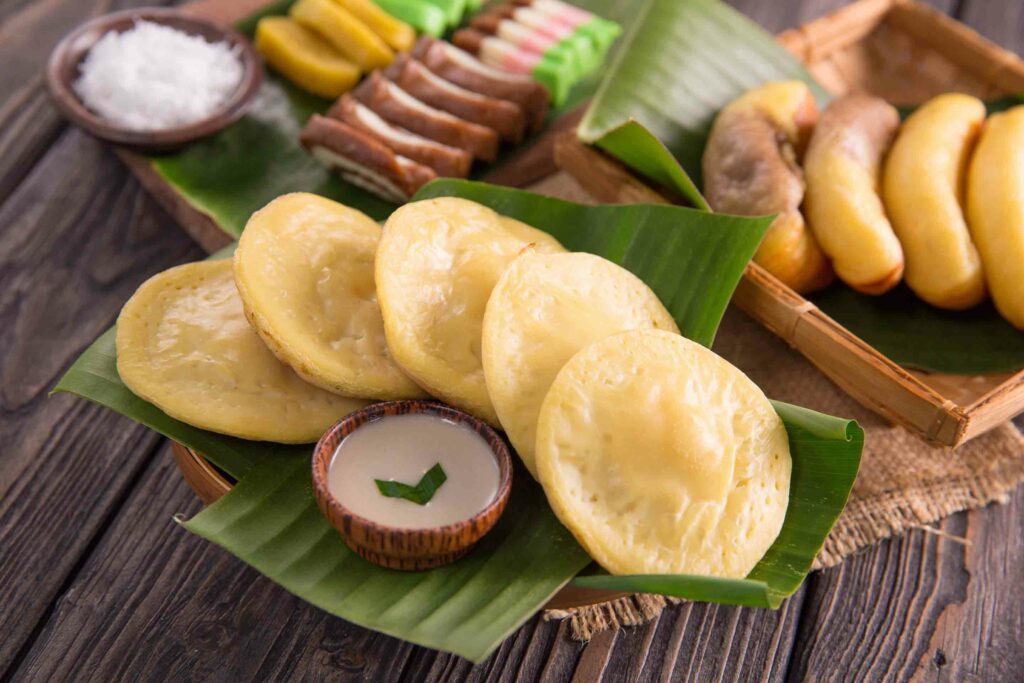
Serabi | Indonesian Pancake
Serabi is an Indonesian pancake originating from Java. It is a Bandung food often in the morning.
You’ll also find it in Bali as it was adapted as a Balinese offering for the Hindu gods.
Made from rice flour and coconut milk or cream, it can be sweet or savory. Although the Sudanese version uses a brown coconut sugar syrup called kinca and is a must try.
It’s often referred to as Indonesian pancake because of it’s shape and resemblance to the Dutch pancake. But it existed long before Dutch colonization and it’s smaller than American style pancakes.
The pancake has some similarities with Indian dosas. Yet serabi is unique with its fluffy, crumpet-like texture. In Thailand there is a similar dish called khanom khrok.
Ketoprak | Tofu Noodle Salad
Perhaps one of the healthiest street food meals you can have for breakfast. Bonus, it’s also very affordable.
It’s a delicious bowl of thin rice vermicelli noodles, tofu, bean sprouts, and sliced cucumber with peanut sauce mixed with sweet kecap manis.
It’s originally a Betawi dish from Jakarta but it’s so good you’ll find regional variations all over.
It was so popular Javanese immigrants brought it to Singapore where it evolved with local tastes and is known as satay bee hoon.
Nasi Uduk | Coconut Rice
Nasi uduk is a fragrant coconut rice dish from Jakarta and a great breakfast in Indonesia.
It is essentially rice cooked in coconut milk with a number of sides. often accompanied by various side dishes like fried chicken, tempeh, and omelette.
You can find it in restaurants but also locals think it’s better traditionally.
It was a common dish for laborers who ordered it take away. Today it’s still wrapped in a banana leaf, which many believe makes the flavor better.
Although it’s considered a Betawi dish, there’s no doubt it was influenced by Malaysian nasi lemak, which is practically identical. The key side dishes are tempeh, small fried fish, egg omelet and red sambal.
The difference is that nasi lemak uses curry sauce and nasi uduk does not.
Nasi Pecel | Rice with Peanut Sauce
There are so many great vegetarian Indonesian breakfasts from Java and Bali.
Nasi pecel is a Javanese dish where steamed rice is served with vegetables and a spicy peanut sauce.
You can always distinguish a Javanese dish by the use of peanut sauce. It’s not as common on other islands,
It’s often served mixed together or you can ask for the sauce on the side like in the above image to manage the sauce to vegetable ratio.
Nasi Tim | Steamed Chicken Rice
Nasi tim is a Chinese-Indonesian dish of steamed rice with chicken, mushroom and hard boiled egg. It is typically seasoned with soy sauce and garlic.
It’s a simple comforting dish similar to Hainanese Chicken Rice in Singapore and Malaysia. But in this case the dish is cooked into a tin mold and served with the chicken mix on top of the rice.
Nasi Kuning | Yellow Rice
Nasi kuning is a vibrant turmeric-flavored rice once reserved for special occasions but today available for breakfast in Indonesia.
This celebratory dish comes from Java and is a common Yogyakarta food. The yellow color from tumeric symbolizes good fortune and indicates Indian influence.
Neighboring countries have similar turmeric rice dishes, such as nasi kunyit in Malaysia and Singapore.
Tempe Mendoan | Fried Tempeh
Tempe Mendoan is more of a breakfast snack and it’s easy to grab and go.
It’s deep-fried tempeh from the Banyumas region in Central Java.
The tempeh is thinly sliced, coated in seasoned batter and fried until half-cooked. The tempeh becomes crunchy on the outside and soft inside.
It’s also a common addition to many popular breakfast dishes for those who want a delicious fried snack. It’s served often with sweet kecap manis or chili.
Bali Fruits
Dadar Gulung Pandan | Pandan Rolled Pancake
Dadar gulung is a green, rolled wheat pancake. It’s filled with sweet coconut and palm sugar, a common breakfast treat in Indonesia.
The green color comes from pandan leaves, which are used more for color than flavor.
You can also find this traditional sweet snack in Brunei and Malaysia.
